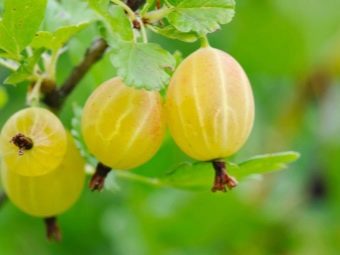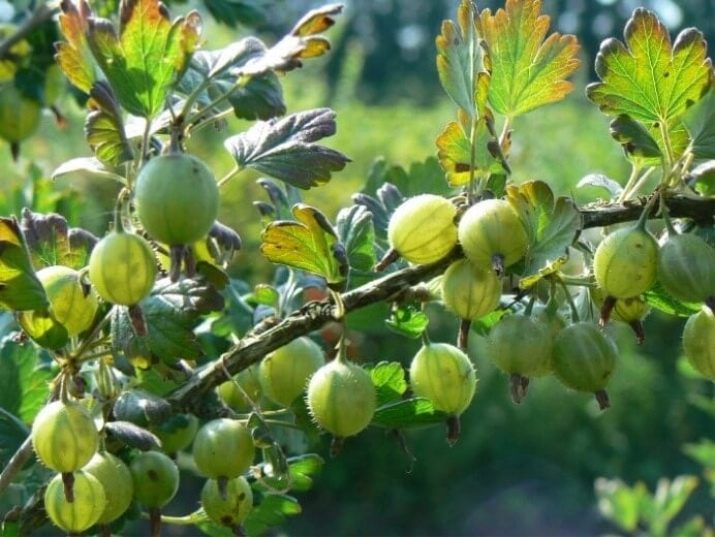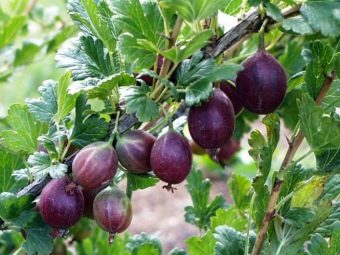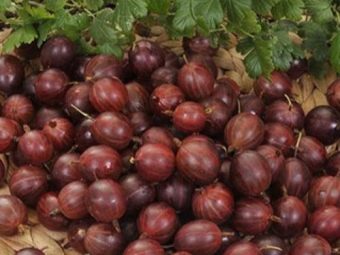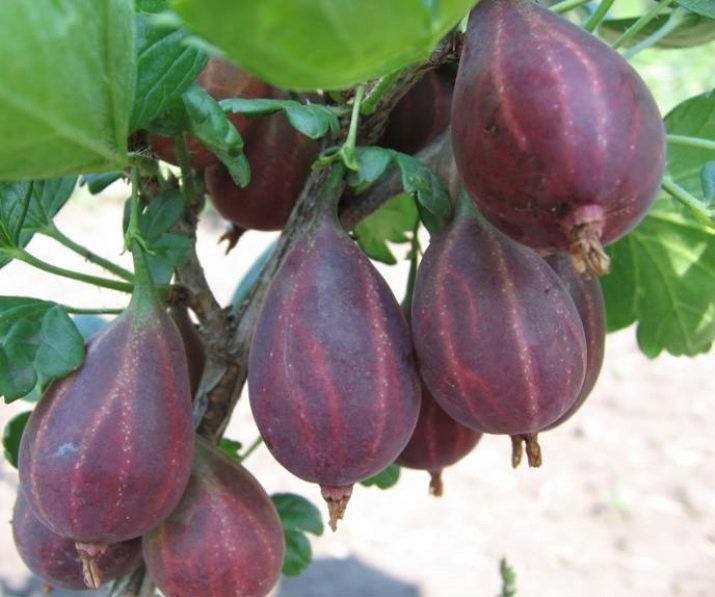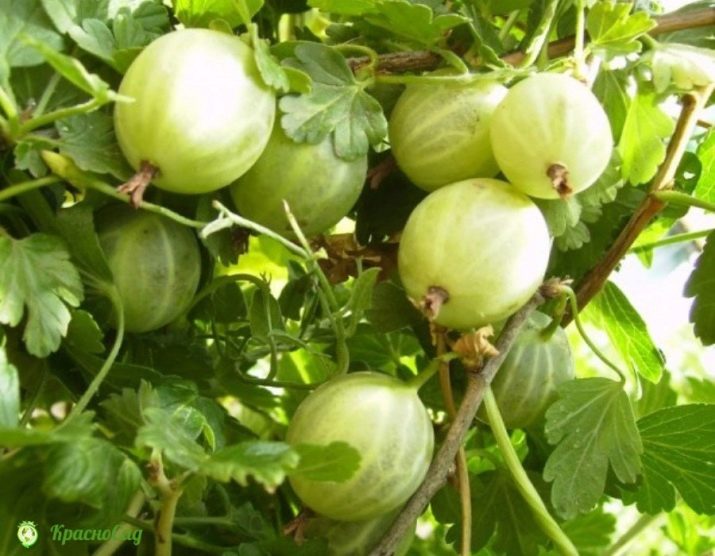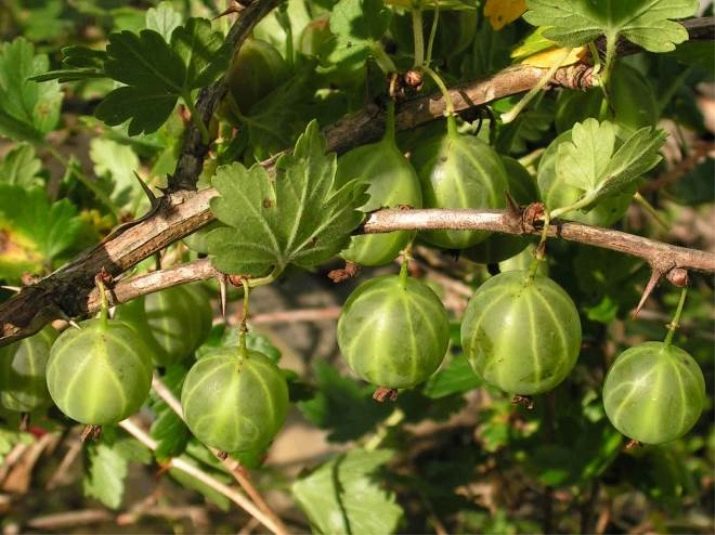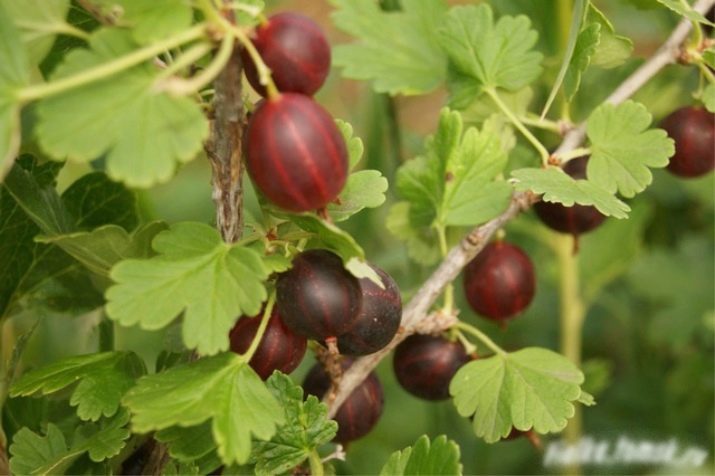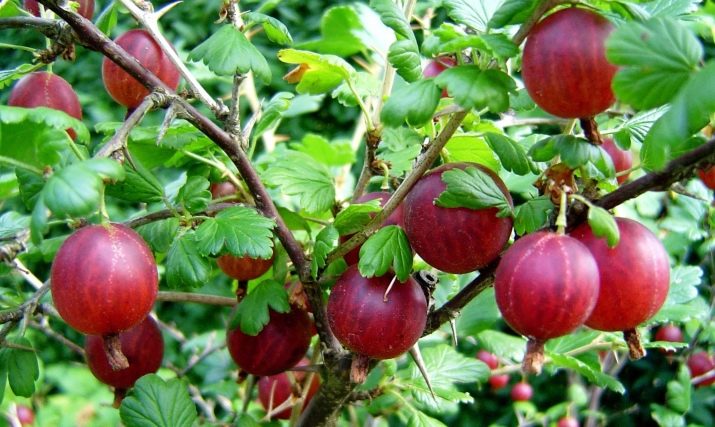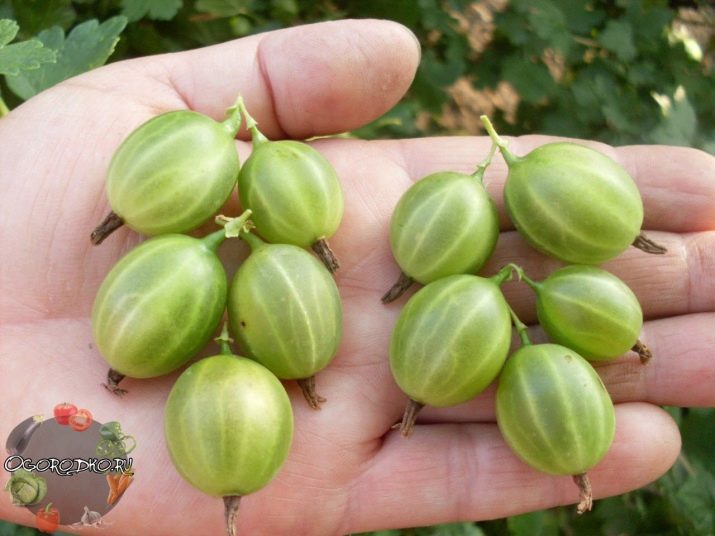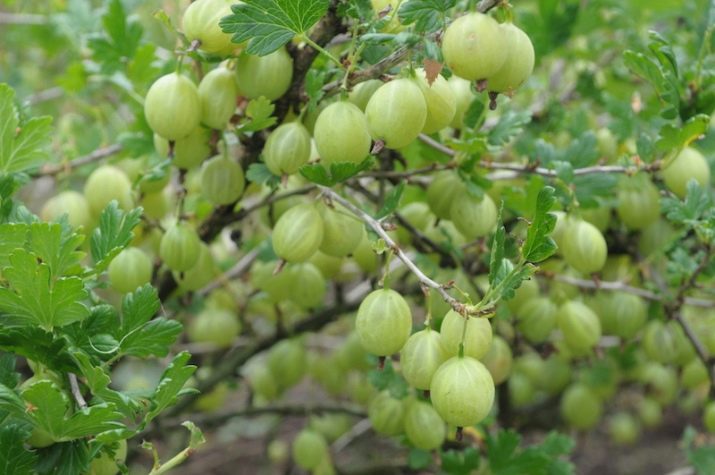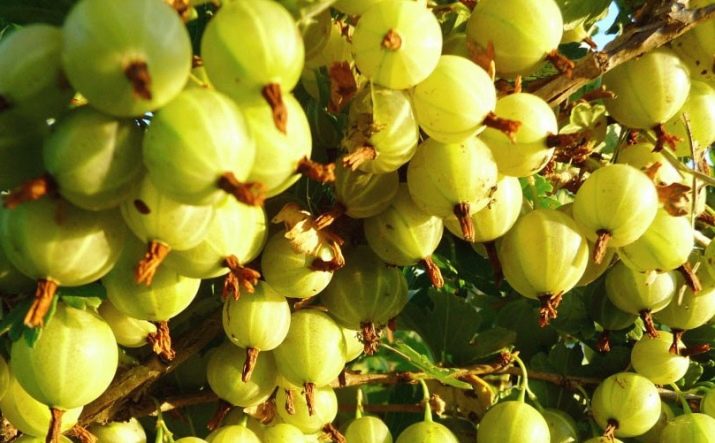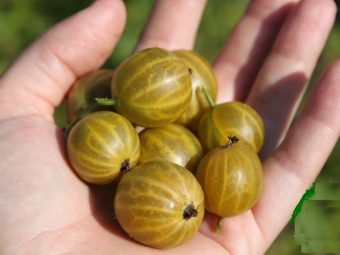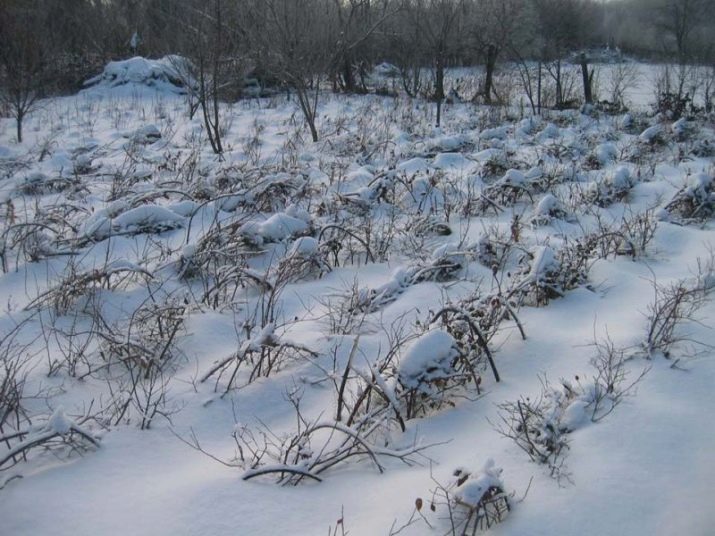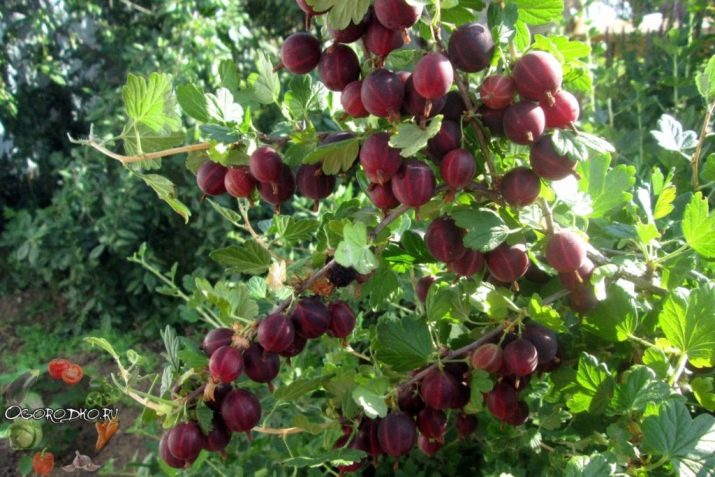Classification of gooseberry varieties and their description
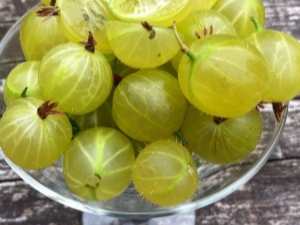
Gooseberry.It is impossible to imagine a garden, a summer cottage without one or several bushes of this culture.
There is a huge number of varieties: prickly and beshipnyh, with berries of black, red, green, yellow flowers, small and large, with different ripening terms. And even more varieties of this common shrub, the classification of which is carried out according to various characteristics.
By origin
Initially, gooseberry leads its history from two species - European and American.
In varieties of European origin, the berries are larger and sweeter than those of the American species. However, "Europeans" are more often affected by diseases, have a low winter hardiness.
On American varieties small berries have a sour taste. But they have several important advantages: this group of varieties practically does not freeze, perfectly tolerates cold winters, very rarely gets sick.
When breeding new promising berries, European and American varieties cross. As a result, the resulting species have a number of beneficial properties: the ability to withstand drought and lack of moisture, frost, spring return frosts, the most common diseases and pests characteristic of a particular area, and also feature large tasty berries.
The preference is most often given to those varieties whose spikes have very little or they are completely absent.
By maturity
If you plant on the site several gooseberry bushes ripen in stages, on different dates, you can enjoy tasty, healthy berries from the beginning of July until the autumn
There are many varieties with a tasting score of 4.8-5 points on a five-point scale. Among the sweetest can be called the variety "Chernomor". This shrub is tall, with small dark red berries that can be enjoyed in late July and early August. It tolerates both low and high temperatures, is not susceptible to powdery mildew. Separately, it should be noted that Chernomore has few thorns, which makes it possible to harvest crops without the threat of being scratched.
The season is opened by early ripe varieties. They are eaten since the second decade of July, and in regions with a warm climate even earlier. One can name only some of the large number of varieties of such varieties.
- "African". The plant is medium. Fruits are elongated, small, gray-black, with spicy sourness, a bit like black currant. The variety is well resistant to drought, frost and fungal diseases, although anthracnose infection is possible to a small extent. Maximum yields are obtained with regular thinning of the bush.
- "Gentle". Compact, grows fast. Fruits are not very large, having a rounded shape and red color, looking shiny, with a pleasant smell, tasty. Cold resistance, yield and ability to resist diseases are at the proper height.
- "Prunes". Slow-borne. Small elongated berries of elongated shape, rich red color, resembling prunes to taste. Marked increased resistance to frost, heat, lack of moisture and spores of pathogenic fungi.
All of the above varieties are united by the fact that there are few spikes on the shoots or they are completely absent.
Pick up the baton mid-season species. For example, the following.
- "Belarusian sugar". Powerful, tall plant, prickly. Stable fruitful. Large-fruited, berries are round, slightly elongated, green. Evaluation of taste from 4.8 to 5 points out of five. Resistance to low temperatures is high, but in wet summer it can be damaged by fungus.
- "Plum". Tall, straight shoots, smooth. Yields are above average. The fruit is a cherry-red color, with a rather large oval shape. The taste is spicy, pleasant. It tolerates cold and drought, rarely affects diseases.
- Hinnonmaki Red. Fast-growing, upright.Winter hardiness, yield, disease resistance - at a decent height. Very beautiful, large red berries will delight you with a wonderful taste. The peculiarity of this variety is stable yields only when planted in a well-lit, sunny place.
And late-season varieties end the season. Already from the name it is clear that they have ripened late, sometimes by early autumn. A few examples of this range of varieties.
- "Candy". Neat, small size bush. Small spikes are mainly located in the radical part of the branches. Boasts high yields. Sweet berries of a small size, round, with a sweet aroma. The variety is resistant to drought, rarely sick. In very harsh winters, the tops of the shoots may slightly freeze.
- "Serenade". The plant is vigorous, shoots are straight, smooth. Rare spikes are just above the soil level. It is characterized by resistance to frost and dry periods. The fruits are slightly elongated, medium-sized, reddish-purple. It tastes sourish, tender.
- "Ural Bearing". Medium sized bush with tilted branches. From the name it is clear that the thorns on the plant are completely absent. Yield, large-fruited. The fruits have a round, slightly elongated shape, bright green color and a pleasant dessert taste. Does not freeze. Drought resistant. Powdery mildew may occur in wet summer.
By the number of spikes
It is traditionally considered that the gooseberry is a very thorny shrub and it is one torment to pick berries from it,
So it really was, but it is already in the past. Many modern species have spikes completely absent or are located exclusively in the root part of the bushes. Thorns may be on young, still non-bearing shoots.
Heavily studded varieties often have larger, juicy and sweet berries, which gives some reason to come to terms with a large number of sharp spines.
As an example, consider the following varieties.
- "Stanichny". The plant is low, but with a strong branching, shoots sloping, slightly curved. Fruits weighing nine - twelve grams, slightly elongated, dark pink shade. Evaluation score of 5 points, fully ripe berries have a pronounced nutty aftertaste. The only drawback is poor winter hardiness, in cold weather without shelter can freeze.
- "Malachite". Strong branch with curved branches. Yield. Green round berries have a weak yellowish tan and a pleasant, slightly sour taste. Resistant to winter cold and powdery mildew.
New Bearing varieties - "Consul", "Ural Besshipny", "Cooperator", "Hero of the Day" - can also boast large fruits with a high tasting score.
- "Cooperator". A small shrub covered with pear-shaped berries of ripe cherry color. Tasters rate their taste by 4.0–4.8 points, weak sourness is felt. In general, the variety is resistant to frost and disease, but in wet, cold summers, anthracnose infection is possible.
- "Anniversary". Mid-season. The plant is small, with thin shoots. Fruits are elongated, dark pinkish, pleasant-looking, and the taste is completely non-acidic. It is not subject to diseases, it is steady against low temperatures.
By the color of the berries
Gooseberry berries can be of different types and colors. Often already from the name you can understand what they are. If not, then you need to read the description in order to accurately determine the choice.
In addition to the usual, smooth, there are bushes with pubescent, "shaggy" fruits, berries, as it were, dressed in velvety "fur coats". Among them, for example, the variety "Elegant" ("People's"). It is a sprawling, medium-sized plant with drooping branches. Round shaped berries. In the process of ripening, the color of the berries changes from pinkish-brown to black. The taste is estimated at 4.5 - 4.8 points out of five. Yield. According to the maturity date, it is rather late.Does not freeze and almost does not get sick.
The following varieties have yellow color: “Honey”, “Russian yellow”, “Altai license plate”, “Amber”, as well as some others. Gardeners on websites and gardening forums talk about the old gooseberries, which grew and bears fruit even from their parents and grandparents. According to the descriptions it is “hairy”, its berries are covered with fine hairs, it tastes fragrant and sweet. The exact name of this variety could not be established.
Characteristics of yellow varieties.
- "Honey". Tall, mid-range. Careful care gives excellent yields. Slightly elongated, golden-yellow fruits smell honey flower. The variety requires special and careful care, capricious, it can be strongly affected by diseases.
- "Russian yellow". It is a clone of the famous variety "Russian". The bush is small, compact. Thorns are available, but in small quantities. Early, annually pleases with an abundance of berries. The berries are round, non-one-dimensional, four to eight grams in weight, sour-sweet, do not fall off and do not crack. In general, the variety is unpretentious, tolerates drought well. However, in wet weather is slightly damaged by fungal diseases.
- "Altai license plate". One of the new varieties. When it was created at the genetic level, immunity to the most common diseases was laid. Keeps up early. A few spikes do not interfere with a bountiful harvest. The fruits of sugar taste, the acid is almost not felt. Well adapted to the vagaries of weather.
Green berries at the gooseberry "Ural Besshipy", "Spring", "Emerald" and a number of varieties.
- "Emerald". It has a small crown size, winter hardiness, few spines. Juicy, glossy-glossy, elongated berries begin to ripen quite early.
- "Spring". Medium height bush compact. Fruits are quite large in size, from five to eight grams in weight, slightly elongated, sweet. Positive qualities of the variety: it is insensitive to spring frosts and thaws, it is not affected by diseases.
- "Beryl". Slightly ragged, almost without prickles. Gleaming round berries have a pleasant sweet taste. High yield gives a stable every year. Not prone to such a common disease as a sphere, winter-hardy.
The red ones are in the “Candy”, “Russian”, “Vladil” varieties and so on.
- "Russian". Strong-growing, few thorns. Numerous large and sweet berries ripen in early terms. Disease resistance is above average.
- "Vladil" (another name "Commander"). The bush is compact, devoid of thorns. Winter-hardy, early, well resists fruit rot. Berries are not very large, sweet taste.
Black colors of berries in the varieties "Harlequin", "Chelyabinsk weak-bearded", "Chernomor", "Defender" and others.
- "Harlequin". Medium early. Shrub erect, half sprawling, spines absent. Fruits are medium-sized, from brownish to black color, a bit like black currant to taste. It tolerates cold winters, is not affected by powdery mildew.
- "Chelyabinsk weak-prickly." The branches of the plant lean to the ground. There are spines, but not very many. Small berries of a pleasant refreshing taste can be tasted in early July. The variety is resistant to frost and diseases.
By the size of the fruit
The gooseberry assortment is presented in various sizes of berries - from very small to large or even giant.
Below are some large-fruited varieties that have immunity to various lesions, as well as increased winter hardiness.
- Aladdin - resistant to temperature changes, the berries are round, yellow-green in color, excellent taste, do not crumble.
- Beryl - has good winter hardiness, without spines.
- Defender - late, prickly. The berries are shaped like a pear, dark, sweet and sour.
- Gingerbread Man - on the branches a small number of thorns. Round fruits look beautiful and have a good taste and delicate aroma.
- Cooperator - without thorns, frost-resistant, rarely affected by diseases.
- Lada - winter-hardy, high-yielding, few thorns, not sick. Berries are reddish-green, oval, taste score from 4.8 to 5 points.
- Leningradets - recommended for cultivation in the North-West region. Poor-toed. Late, high-yielding. Fruits are shaped like an egg of red saturated color and good taste.
- Muscat - prickles on young branches, does not freeze slightly, but defeat by powdery mildew is possible. Medium early. The berries are pale pinkish, oval, fragrant, with a characteristic flavor.
- Northerner - resistant to frost. Barbed. Berries are yellow-green.
- Seraphim - nepriyuchy, early maturing. Rounded berries, red, refreshing taste.
- Ural pink - prickly, not prone to disease.
From small-fruited it is possible to distinguish the following sweet fruit varieties:
- "Harlequin" - ripen early, there are no spines.
- "Lollipop" - Late, resembles fruit lozenges to taste, covered with spikes.
- "White Nights" - it is not damaged by powdery mildew, tasters estimate berries by 4.8 points.
- "Sirius" - for all regions. It is equally calm with both low and high temperatures. Dizziness is weak. Dark sweet berries with a slight sourness.
By disease resistance
Scientists - breeders and experienced practitioners are constantly working to improve the resistance to various diseases. Cultivars are derived and tested with genetic protection from the most common gooseberry diseases.
At the same time, natural-climatic conditions and the composition of the soil of the region in which the cultivation and distribution of this species is intended is taken into account. For example, for the North-West region, with its cool and damp summer, fungal infections pose a great threat.
Taking into account this specificity, the Northern Captain variety has been created, adapted to the cataclysms of nature. Its main advantage is increased resistance to cold, disease and pests - sawfly and fire scum. On the strong branchy branches of the plant there are almost no thorns. Among the shortcomings can be noted the relative small-fruited and sour taste of dark, almost black berries. But on the other hand, you can make very tasty blanks for the winter, make a healthy homemade wine.
By growing in the regions
Russia is a huge country. The climatic conditions of the northern and southern, western and eastern regions are very different.
So that gardeners from different regions could grow their favorite shrubs without any problems, horticultural research institutes develop varieties taking into account all the peculiarities of the climate.
The gooseberry for the north must resist frost well, survive a long and harsh winter without loss, have a good harvest in a short cool summer, resist disease and be ready for winter again.
So, in the north-west and in the middle zone of the country, the following varieties will grow and bear fruit without any problems.
- Grushenka - large, almost black berries of sweet and sour ripen late. The absence of spines allows you to safely collect them. Frost-resistant, well withstands the most common diseases
- Gingerbread Man - mid-season, slightly spiky. Fruits are round, large, cherry color, tasty. The variety has immunity against powdery mildew and anthracnose.
- Chernomor - resistant to diseases, temperature drops, frost.
- North captain - hardy variety.
And also suitable for cultivation in the area, including the Leningrad region, species bred in the Urals and Siberia.
In the south, another problem - the bushes need to learn how to easily endure the scorching heat for a long time, as well as a possible drought. On the other hand, the favorable climate makes it possible to calmly plant a gooseberry with a rather long growing season, it will have time to give a harvest and calmly meet some decrease in temperature.
- African - pruning is needed for good fruiting.
- Belarusian sugar - large and sweet, may require protection from diseases.
- Commander (another name Vladil) - resists spherotek and rot. The taste of berries has earned a high appreciation of tasters.
- Kubanets - sprawling, few thorns. The berries are rounded, green, sweet, slightly sour.
- Spring - srednerosly, prickly. Fruits of large size, light yellow, sweet, long hang on the branches. Not affected by powdery mildew.
Varieties of this group are united by increased resistance to pests, which are especially numerous in areas with warm and short winters.
The climate of the middle zone is characterized by relatively mild winters (although severe frosts also occur) and warm summers. In the spring, thaws, early thawing of snow, recurrent chills and frosts during the flowering of fruit and berry crops are possible. Here we need varieties that bloom at a later date.
When choosing varieties for the Moscow region, you should pay attention to those that grow well in the north-west and in the middle lane.
For the Urals, hardy species are needed that are able to withstand the volatility and the vagaries of the weather — winter cold, a short, sultry (and often dry) summer, frosts in June and August. Although it happens with exactly the opposite - there is no summer at all, only cold and rain.
Just as in the Urals, it is important for Siberia that the varieties have a short growing season (time from the start of bud break until the end of the leaves) and can prepare for a long winter. It is better to give preference to medium and undersized varieties with high winter hardiness. When planting tall varieties there is the likelihood of freezing tops that will not be covered by snow.
In general, the climate of the regions of the Urals and Siberia is in many ways similar, therefore the varieties will suit the same.
- Ural pink. The plant is small, shoots are covered with spines. Medium early ripening. Early-ripening fruits are round, from pink to dark in color, excellent taste. Not damaged by disease and frost.
- Ural emerald. Early, prickly. The berries are elongated and round, green, very sweet. Does not freeze, resistant to major diseases and pests.
- Senator (Consul) - srednerakidisty. The twigs are slightly curved. Without damage transfers winter. Sickly rare. Yield. Fruits are medium-sized, elongated, saturated red color, sourness is felt in taste.
- Malachite - resistant to frost and powdery mildew.
- Reliable. Spreading, branches grow obliquely, few thorns. The berries are small, burgundy, fragrant. Can hang for a long time without flaking. The main disadvantage is that it does not tolerate drought.
- Beryl - almost devoid of thorns, winter-hardy.
- Hero of the day - also without thorns, the berries are large and very sweet.
All of the above nuances must be considered when choosing a gooseberry for planting.
Reviews
Since the climate of different regions of our country varies greatly, there can be no consensus about which variety of gooseberry is better. Those that grow well in the south are not adapted for Siberia and the Urals. Accordingly, the Siberian varieties may produce less yield in the middle lane.
Each gardener should take into account the following factors: the climate of his area, the composition of the soil on the site, and be sure to look at whether the variety he likes fits the conditions of the region (better if it is zoned). And also when planting a gooseberry you need to choose the right place for it. Best of all, if it is sunny, well lit area, at a small elevation, protected from the cold northern winds hedges or some buildings.
Most varieties will provide high yields only with proper care and compliance with all measures for the prevention of diseases, timely thinning of shrubs, and removal of weeds. Do not neglect dressing - root, combined with irrigation, and foliar (spraying). The latter can be carried out in conjunction with the treatment of diseases or pests. Only in this case it will be possible for many years to enjoy delicious berries from your own garden.
Video review of gooseberry varieties, see the following video.

